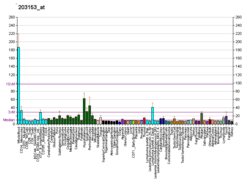IFIT1
Interferon-induced protein with tetratricopeptide repeats 1 is a protein that in humans is encoded by the IFIT1 gene.[5][6][7]
References
- 1 2 3 GRCh38: Ensembl release 89: ENSG00000185745 - Ensembl, May 2017
- 1 2 3 GRCm38: Ensembl release 89: ENSMUSG00000067297 - Ensembl, May 2017
- ↑ "Human PubMed Reference:".
- ↑ "Mouse PubMed Reference:".
- ↑ Lafage M, Clauss I, Couez D, Simonetti J, Wathelet MG, Huez G (Jul 1992). "The interferon- and virus-inducible IFI-56K and IFI-54K genes are located on human chromosome 10 at bands q23-q24". Genomics. 13 (2): 458–60. doi:10.1016/0888-7543(92)90272-T. PMID 1377167.
- ↑ Wathelet MG, Clauss IM, Content J, Huez GA (Jun 1988). "The IFI-56K and IFI-54K interferon-inducible human genes belong to the same gene family". FEBS Lett. 231 (1): 164–71. doi:10.1016/0014-5793(88)80724-5. PMID 3360121.
- ↑ "Entrez Gene: IFIT1 interferon-induced protein with tetratricopeptide repeats 1".
Further reading
- Wathelet MG, Clauss IM, Nols CB, et al. (1988). "New inducers revealed by the promoter sequence analysis of two interferon-activated human genes". Eur. J. Biochem. 169 (2): 313–21. doi:10.1111/j.1432-1033.1987.tb13614.x. PMID 3121313.
- Wathelet MG, Szpirer J, Nols CB, et al. (1988). "Cloning and chromosomal location of human genes inducible by type I interferon". Somat. Cell Mol. Genet. 14 (5): 415–26. doi:10.1007/BF01534709. PMID 3175763.
- Kusari J, Szabo P, Grzeschik KH, Sen GC (1987). "Chromosomal localization of the interferon-inducible human gene encoding mRNA 561". J. Interferon Res. 7 (1): 53–9. doi:10.1089/jir.1987.7.53. PMID 3585080.
- Wathelet M, Moutschen S, Defilippi P, et al. (1986). "Molecular cloning, full-length sequence and preliminary characterization of a 56-kDa protein induced by human interferons". Eur. J. Biochem. 155 (1): 11–7. doi:10.1111/j.1432-1033.1986.tb09452.x. PMID 3753936.
- Chebath J, Merlin G, Metz R, et al. (1983). "Interferon-induced 56,000 Mr protein and its mRNA in human cells: molecular cloning and partial sequence of the cDNA". Nucleic Acids Res. 11 (5): 1213–26. doi:10.1093/nar/11.5.1213. PMC 325791. PMID 6186990.
- Rebouillat D, Marié I, Hovanessian AG (1998). "Molecular cloning and characterization of two related and interferon-induced 56-kDa and 30-kDa proteins highly similar to 2'-5' oligoadenylate synthetase". Eur. J. Biochem. 257 (2): 319–30. doi:10.1046/j.1432-1327.1998.2570319.x. PMID 9826176.
- Guo J, Sen GC (2000). "Characterization of the Interaction between the Interferon-Induced Protein P56 and the Int6 Protein Encoded by a Locus of Insertion of the Mouse Mammary Tumor Virus". J. Virol. 74 (4): 1892–9. doi:10.1128/JVI.74.4.1892-1899.2000. PMC 111667. PMID 10644362.
- Guo J, Peters KL, Sen GC (2000). "Induction of the human protein P56 by interferon, double-stranded RNA, or virus infection". Virology. 267 (2): 209–19. doi:10.1006/viro.1999.0135. PMID 10662616.
- Guo J, Hui DJ, Merrick WC, Sen GC (2001). "A new pathway of translational regulation mediated by eukaryotic initiation factor 3". EMBO J. 19 (24): 6891–9. doi:10.1093/emboj/19.24.6891. PMC 305884. PMID 11118224.
- Patzwahl R, Meier V, Ramadori G, Mihm S (2001). "Enhanced Expression of Interferon-Regulated Genes in the Liver of Patients with Chronic Hepatitis C Virus Infection: Detection by Suppression-Subtractive Hybridization". J. Virol. 75 (3): 1332–8. doi:10.1128/JVI.75.3.1332-1338.2001. PMC 114039. PMID 11152506.
- Strausberg RL, Feingold EA, Grouse LH, et al. (2003). "Generation and initial analysis of more than 15,000 full-length human and mouse cDNA sequences". Proc. Natl. Acad. Sci. U.S.A. 99 (26): 16899–903. doi:10.1073/pnas.242603899. PMC 139241. PMID 12477932.
- Gavrilov BG, Monastyrskaia GS, Velikodvorskaia TV, et al. (2003). "[Late activation of interferon-induced genes IFI-54k and IFI-56k in human RH cells infected with tick-borne encephalitis virus]". Bioorg. Khim. 29 (2): 175–80. PMID 12708317.
- Ota T, Suzuki Y, Nishikawa T, et al. (2004). "Complete sequencing and characterization of 21,243 full-length human cDNAs". Nat. Genet. 36 (1): 40–5. doi:10.1038/ng1285. PMID 14702039.
- Gerhard DS, Wagner L, Feingold EA, et al. (2004). "The Status, Quality, and Expansion of the NIH Full-Length cDNA Project: The Mammalian Gene Collection (MGC)". Genome Res. 14 (10B): 2121–7. doi:10.1101/gr.2596504. PMC 528928. PMID 15489334.
- Rual JF, Venkatesan K, Hao T, et al. (2005). "Towards a proteome-scale map of the human protein-protein interaction network". Nature. 437 (7062): 1173–8. doi:10.1038/nature04209. PMID 16189514.
- Kimura K, Wakamatsu A, Suzuki Y, et al. (2006). "Diversification of transcriptional modulation: Large-scale identification and characterization of putative alternative promoters of human genes". Genome Res. 16 (1): 55–65. doi:10.1101/gr.4039406. PMC 1356129. PMID 16344560.
- Terenzi F, Hui DJ, Merrick WC, Sen GC (2006). "Distinct induction patterns and functions of two closely related interferon-inducible human genes, ISG54 and ISG56". J. Biol. Chem. 281 (45): 34064–71. doi:10.1074/jbc.M605771200. PMID 16973618.
This article is issued from
Wikipedia.
The text is licensed under Creative Commons - Attribution - Sharealike.
Additional terms may apply for the media files.




